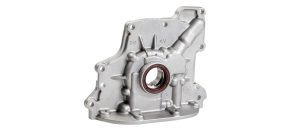An engine is a complex machine with hundreds of moving parts, all working together under high temperatures and pressures. For these components to function efficiently and avoid premature wear, lubrication is essential. At the center of this lubrication system is the oil pump — the part responsible for circulating oil throughout the engine.
Without a properly working oil pump, even the best engine oils cannot prevent damage. In this article, we will explore how oil pumps work, common types, signs of failure, and why timely replacement is critical for engine health.
The Role of the Oil Pump in an Engine

The oil pump is typically located inside the oil pan (sump) at the bottom of the engine. Its primary function is to draw oil from the sump and force it through the oil filter before distributing it to bearings, pistons, camshafts, and other moving parts.
Key Functions of the Oil Pump:
-
Maintains Oil Pressure – Ensures proper circulation and keeps vital components lubricated.
-
Reduces Friction – Prevents metal-to-metal contact that causes wear.
-
Cooling Effect – Helps carry heat away from engine parts.
-
Supports Hydraulic Systems – Supplies oil pressure for hydraulic lifters and timing chain tensioners.
-
Removes Debris – Works with the filter to capture metal shavings and contaminants.
Types of Oil Pumps
Oil pumps come in different designs depending on the vehicle and engine requirements.
| Type of Oil Pump | Description | Pros | Cons |
|---|---|---|---|
| Gear Pump | Uses meshing gears to pump oil; simple and durable. | Reliable, long-lasting, affordable. | Less efficient at low RPM. |
| Rotor Pump (Gerotor) | Uses an inner and outer rotor to move oil. | Compact, efficient, used in modern engines. | Sensitive to wear, requires clean oil. |
| Vane Pump | Uses sliding vanes in a rotor to move oil. | Smooth flow, quieter operation. | More complex and expensive. |
| Variable Displacement Pump | Adjusts oil flow depending on engine demand. | Fuel-efficient, reduces parasitic losses. | More expensive and complex design. |
What Happens If the Oil Pump Fails?
An oil pump failure is one of the most dangerous problems for any engine. Since lubrication stops almost immediately, severe damage can occur within seconds.
Common Consequences:
-
Overheating due to lack of lubrication.
-
Rapid wear of bearings and pistons.
-
Seizure of moving components.
-
Total engine failure if ignored.
Signs of a Failing Oil Pump
Recognizing early warning signs of oil pump problems can save you from costly repairs.
Warning Signs to Watch For:
-
Low Oil Pressure Warning Light – One of the first indications that oil flow is inadequate.
-
Engine Overheating – Lack of oil circulation increases internal friction and heat.
-
Loud Ticking or Knocking Noises – Caused by insufficient lubrication of valves and bearings.
-
Increased Engine Wear – Visible during maintenance, such as scored bearings.
-
Oil Pressure Gauge Fluctuations – Indicates inconsistent pump performance.
Causes of Oil Pump Failure
While oil pumps are designed to last, several factors can lead to premature failure.
| Cause | Description |
|---|---|
| Lack of Oil Changes | Dirty or old oil clogs the pump and accelerates wear. |
| Contaminants in Oil | Metal shavings, dirt, or sludge can damage pump gears/rotors. |
| Wear and Tear | High mileage engines experience natural pump wear. |
| Incorrect Oil Type | Using oil that is too thick or too thin can stress the pump. |
| Overheating | Excessive engine heat can weaken pump seals and reduce efficiency. |
When Should You Replace the Oil Pump?

Oil pumps don’t have a fixed replacement interval, but they should be checked during major engine service or rebuilds. If you notice any of the above warning signs, replacement is strongly recommended.
Replacement Checklist:
-
Low oil pressure despite correct oil level.
-
Visible wear or damage on pump gears/rotors.
-
Noise from the oil pan area.
-
Engine components showing early wear due to poor lubrication.
To ensure quality and fit, you can buy Oil Pumps online for your specific vehicle model.
Maintaining Oil Pump Health
Preventive maintenance is the best way to extend the life of your oil pump.
Maintenance Tips:
-
Regular Oil Changes – Follow manufacturer intervals with high-quality oil.
-
Use the Right Oil – Stick to the recommended viscosity grade.
-
Replace Oil Filters – Prevents debris from reaching the pump.
-
Monitor Oil Pressure – Keep an eye on your dashboard light or gauge.
-
Inspect During Engine Work – If rebuilding or servicing the engine, check the pump condition.
Oil Pump vs. Oil Pressure Sensor Issues
Sometimes, what appears to be oil pump failure is actually a faulty oil pressure sensor.
| Symptom | Likely Cause |
|---|---|
| Low oil pressure light only | Faulty sensor or wiring issue. |
| Noises + overheating | Likely real oil pump failure. |
| Pressure fluctuations only | Could be a failing sensor. |
| Metal shavings in oil | Actual pump and engine wear. |
When in doubt, have a mechanic test both the pump and the sensor before replacing parts.
Conclusion
The oil pump may not be a part you think about often, but it is the heart of your engine’s lubrication system. Without it, friction, heat, and wear can destroy vital components in minutes.
By understanding how the oil pump works, recognizing signs of failure, and maintaining your oil system properly, you can protect your engine from costly damage. And if a replacement is needed, always ensure you buy Oil Pumps online to guarantee compatibility and durability.